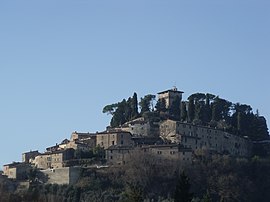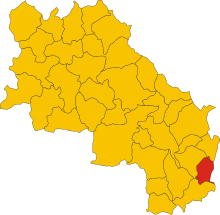Cetona
| Cetona | ||
|---|---|---|

|
|
|
| Country | Italy | |
| region | Tuscany | |
| province | Siena (SI) | |
| Coordinates | 42 ° 58 ′ N , 11 ° 54 ′ E | |
| height | 385 m slm | |
| surface | 53.19 km² | |
| Residents | 2,563 (Dec 31, 2019) | |
| Population density | 48 inhabitants / km² | |
| Post Code | 53040 | |
| prefix | 0578 | |
| ISTAT number | 052008 | |
| Popular name | Cetonesi | |
| Patron saint | Santo Stefano (December 26th) | |
| Website | Cetona | |
 Panorama of Cetona |
||
Cetona is a Tuscan municipality with 2563 inhabitants (as of December 31, 2019) in the province of Siena .
geography
The place extends over 53 km² . It is located on the mountain of the same name, Monte Cetona and in the Senese part of the Chiana Valley (Val di Chiana Senese). The municipality is located about 60 km southeast of the provincial capital Siena and about 100 km southeast of the regional capital Florence . Italy's capital Rome is approx. 130 km south. Cetona is in the climatic classification of Italian communities in zone D, 2,000 GG. Important bodies of water in the municipality are the Torrenti Bargnano (7 of 7 km in the municipality), Chietino (5 of 5 km in the municipality) and Astrone (5 of 22 km), all of which belong to the Tiber river system .
One of the districts of Cetona is Piazze (399 m, approx. 725 inhabitants), which is approx. 8 km south of the main town and has belonged to Cetona since 1808. The nearby area of Camporselvoli was added in 1814 and previously belonged to San Casciano dei Bagni.
The neighboring municipalities are Chiusi , Città della Pieve ( PG ), Fabro ( TR ), San Casciano dei Bagni and Sarteano .
Name origin
There are the following assumptions about the origin of the name Cetona:
- Cetona or Citonia is said to come from the Latin word caedita (English: felled or deforested ).
- According to other sources, the name Cetona may have originated from an Etruscan settlement near the Chieteno stream.
history
The place Cetona arose around the hill of the castle ( Rocca ). The castle was first mentioned in 1207 and belonged to the Aldobrandeschi . After a long quarrel with Siena , Orvieto conquered Cetona in 1260. The reign of Orvieto lasted until 1354, then took over the Count of Monte Marte and Corbara the village until 1367, when the Papal States occupied the area. Braccio da Montone , lord (signore) Perugia , occupied Cetona in 1418. Then the Republic of Siena bought the village, reinforced the city walls and equipped them with three city gates. In 1455 Cetona was briefly occupied and badly damaged by the condottiere Jacopo Piccinino, son of Niccolò Piccinino . The castle was restored by the Republic of Siena until 1458 and the city walls reinforced. After the defeat of Siena in 1555, imperial troops appeared in front of Cetona in 1556. The residents then surrendered without resistance. Then Cetona fell to the Grand Duchy of Tuscany . In the same year Cosimo I sold Cetona to Chiappino Vitelli , who moved the town center from the Borgo below the castle to today's Piazza Garibaldi . Later the place fell back to the Grand Duchy of Tuscany. After the territorial reform of Pietro Leopoldo d'Asburgo-Lorena in 1777 , Cetona initially belonged to Sarteano and became an independent municipality in 1807.
Attractions
Castles, palazzi and city fortifications
- The castle (Castello, also called Rocca ) is privately owned.
- Castello Camporsevoli , castle and Borgo above the district of Piazze.
- On the other important hill is the park and the Palazzo a Parco Terrosi with the Villa La Vagnola , which was built from 1750 for the wedding of Salustio Terrosi and Maria Antonietta Vagnoli.
- Umberto I. Ospedale , active hospital from 1914 to 1964.
- Palazzo Minutelli , palace from the 16th century, seat of the town hall since 1873 and the seat of the museum since 1990.
- Rivellino , tower of the fortification, was built in the 16th century. (The most beautiful places in Italy).
- Porta di Finoglio , city gate that was built under the Medici and is now only referred to by a sign.
Churches and monasteries
- Collegiata della Santissima Trinità , first mentioned in 1228 church in the center below the Rocca. The current structure was built between 1471 and 1475, the side aisle is from the late 16th century. In the 17th century the church was given a baroque style, which was corrected in 1942. In the same year, the frescoes were discovered during the renovation work. Contains the fresco Assunzione della Vergine , which is attributed to Pinturicchio .
- Monastero della Congregazione della Beata Vergine della regola delle Domenicane , usually just called Le Monache , former Dominican monastery within the Borgo. Inaugurated in 1605 and abandoned in 1809.
- Chiesa di San Michele Arcangelo , also called San Michele Arcangelo al Trivio , built in 1155 and expanded in 1614 in the lower town center near the piazza. Contains a wooden statue ( Madonna delle Grazie , first chapel on the right) and a canvas painting ( Madonna e Santi , second altar on the right) from the 16th century. The baptismal font from travertine dates back to the 1938th
- Chiesa della Santissima Annunziata , former church in the piazza. Now used as a museum (Sala Santissima Annunziata) and tourist information office.
- Convento di San Francesco (also called Convento del Monte Pessolano ), convent that was created in 1212 and is located approx. 1 km northwest of Cetona. Contains the work Madonna col Bambino (also called Madonna del Soccorso ) by Sano di Pietro and a Madonna col Bambino by Girolamo di Benvenuto (both are now in the Museum of Chiusi).
- Eremo di Santa Maria in Belverde , hermitage built in 1367 between Monte Cetona and Cetona near Belverde.
- Chiesa di San Lazzaro , former church from the 16th century in the center of the district of Piazze.
- Cappella del Tamburino , chapel in the district of Piazze.
- Chiesa di San Giovanni Battista a Camporsevoli , church inside Camporsevoli Castle from the 13th or 14th century with frescoes from the 16th century.
Museums
- Museo Civico per la Preistoria del Monte Cetona , museum in the Palazzo Minutelli in the town center (Borgo)
- Parco Archeologico Naturalistico di Belverde
Awards
- The place is a member of the association I borghi più belli d'Italia .
- The place is sponsor of the Bandiera Arancione of the TCI .
traffic
- Cetona is connected to the A1 ( Autostrada del Sole ) via the Chiusi-Chianciano Terme junction . The junction is about 7 km north of Cetona.
- The nearest train station is that of Chiusi-Chianciano Terme in Chiusi Scalo, about 7 km northeast of Cetona.
literature
- Laura Martini (ed.): I Luoghi della Fede: Montepulciano e la Valdichiana senese. Arnoldo Mondadori Editore , Milan 1999, ISBN 88-04-46787-8 , pp. 163-168.
- Angelo Molaioli: Cetona. Ricordi per il futuro. Testimonials, photo, cartoline d'epoca per una storia scritta dalla gente. Emmecipi, Bologna 2006, ISBN 978-88-902082-1-8 ( excerpts from Google books )
- Emanuele Repetti: CETONA (Citonia) in Val di Chiana. In Dizionario Geografico Fisico Storico della Toscana (1833–1846), online edition of the University of Siena (pdf, ital.)
- Touring Club Italiano : Toscana. Milan 2003, ISBN 88-365-2767-1 , p. 767 ff.
Web links
- Official website of the municipality of Cetona
- Website of the Pro Loco in Cetona
- Cetona on I borghi più belli d'Italia ( The most beautiful villages in Italy )
- Website of the Museo Civico per la Preistoria del Monte Cetona and the Parco Archeologico Naturalistico di Belverde
Individual evidence
- ↑ Statistiche demografiche ISTAT. Monthly population statistics of the Istituto Nazionale di Statistica , as of December 31 of 2019.
- ^ Comuni Italiani zu Cetona , accessed on June 5, 2014 (Italian)
- ↑ Website of the Agenzia nazionale per le nuove tecnologie, l'energia e lo sviluppo economico sostenibile (ENEA) , accessed on December 25, 2014 (Italian) (PDF; 330 kB)
- ↑ Official website of the Sistema Informativo Ambientale della Regione Toscana (SIRA) on the rivers in Cetona , accessed on December 25, 2014 (Italian)
- ↑ Official website of the Istituto Nazionale di Statistica (2001), accessed on June 5, 2014 (Italian)
- ↑ a b c d e Angelo Molaioli: Cetona. Ricordi per il futuro.
- ↑ a b c d e f g Laura Martini (ed.): I Luoghi della Fede: Montepulciano e la Valdichiana senese.
- ^ A b c Touring Club Italiano: Toscana.
- ↑ a b c Emanuele Repetti: CETONA (Citonia) in Val di Chiana.
- ↑ Villa La Vagnola ( Memento of the original from November 20, 2009 in the Internet Archive ) Info: The archive link was inserted automatically and has not yet been checked. Please check the original and archive link according to the instructions and then remove this notice. on the website of Regione Toscana, accessed on December 25, 2014 (Italian)
- ↑ a b c Website of the Pro Loco Cetona
- ^ I borghi più belli d'Italia. Borghipiubelliditalia.it, accessed August 6, 2017 (Italian).
- ↑ Ecomuseo Valdichiana zu Cetona , accessed on December 25, 2014 (Italian)
- ↑ The Cappella del Tamburino on the Chiese Italiane website (Ufficio Nazionale per i Beni Culturali Ecclesiastici e Servizio Informatico della Conferenza Episcopale Italiana), accessed on December 16, 2014 (Italian)
- ^ Cetona on the pages of I borghi più belli d'Italia.
- ^ Official website of the TCI on the Bandiera Arancione and Cetona , accessed on June 1, 2015 (Italian)





